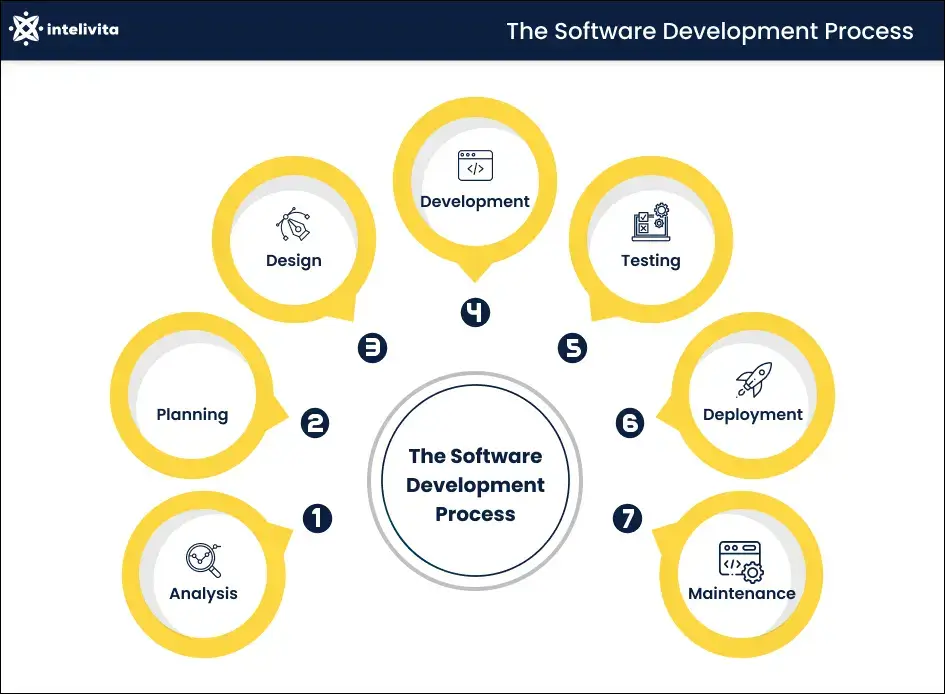Software development is a complex process that involves many different steps, from planning and design to development and testing.
But what does it all look like?
In this article, we’ll take a closer look at the software development process, from start to finish.
We’ll also talk about some of the best practices for a successful software development project.
What is a Software Development Process?
Software development process is a methodical way to create and manage software that involves several steps:
- Understand what the software should do and plan how to build it
- Design how the software will work and look, followed by writing the actual code
- Conduct rigorous testing to ensure it functions properly
- Deploy the software to make it available for users
- Once done, perform ongoing maintenance to keep it running smoothly.
In the following sections, we’ll discuss the software development processes in more detail.
Looking for bespoke software development services to bring your ideas to life?
Book your FREE 30-minute consultation with Intelivita’s experts today!
The 7 Steps of Software Development Process
The time between the product being initially designed and finally released is called a software development lifecycle (SDLC).
To create high-quality software, development teams usually go through these seven stages:
1. Analysis: Understanding the Requirements
Before jumping into the software development process, you need to know exactly what it should do and how it will be used.
Various techniques can help in this process:
- Document Analysis: Start by collecting and evaluating existing documents related to the current system, such as technical specifications, user manuals, and API documentation.
- Interviews: Who will use the software? What do they need it to do? Interview the stakeholders to learn about their needs.
- Observation: Take notes from existing software, so you can understand how it works and what users like and dislike about it.
- Workshops: Organize workshops with users and stakeholders to discover, define, scope, and prioritize their needs in the new software system.
- Prototyping: A prototype is a simple model of the software. Create prototypes to show users and stakeholders what the software will look like and how it will work.
2. Planning: Setting the Foundation
In the next phase of the software development life cycle, software engineers will lay the groundwork through several essential steps:
- Objective Understanding: Begin by comprehending the software’s goals, purposes, and development approach.
- Task Lists: Create detailed task lists using tools like Jira or Asana.
- Team Responsibilities: Assign specific responsibilities to team members to ensure a coordinated effort.
- Progress Tracking: Continuously monitor the project’s progress to stay on course.
- Proactive Problem Solving: Anticipate and plan for potential project challenges to mitigate risks.
- Cost Evaluation: Calculate project costs using various methods, such as expert consultations, historical project analysis, and comparative assessments.
- Comprehensive Estimate: Cost estimate covers all project expenses, including labor, equipment, software, and travel, ensuring it is both practical and all-encompassing.
3. Design: Crafting the Details
After that, create detailed plans on how the custom software will work and look. This stage requires a collaborative approach from both software engineering and design teams.
System Design
This is a detailed blueprint for your software. It describes the system’s components and how they will interact with each other.
During system design, take these factors into account:
- Functional Requirements: What tasks the software needs to accomplish.
- Non-Functional Requirements: How efficiently it should operate and the level of security it demands.
- Restrictions: Any limitations, such as technical or budgetary constraints.
Software Architecture Design
This phase revolves around determining how each component of the software will be constructed.
Carefully consider which programming languages, tools, and software development methodologies to employ.
Your focus should lie in:
- Modularity and Testability: Craft high-level software that’s user-friendly and easy to test.
- Scalability: Prepare the software to handle increased workloads if required in the future.
User Interface/User Experience (UI/UX) Design
This describes how the software will look and feel. It includes information on the layout, colors, and fonts that will be used.
UX design prioritizes:
- User-Centricity: Ensuring ease of use and comprehension.
- Consistency: Keeping a uniform style throughout the software.
4. Development: Writing the Code
After the design is done, it’s time to write the code.
During development, the team members use programming languages and technologies to turn the design into working software.
They create code that does things like showing the user interface, handling data, and talking to other systems.
Development usually takes the most time because it’s the heart of the process.
The development team sticks to the software requirements to build something that meets what the stakeholders want.
If the earlier stages were done well and the requirements were clear, development should be quite straightforward. Companies often develop a minimum viable product (MVP) first to see how software performs in the real world. An MVP is a solution with the fewest necessary features.
5. Testing: Ensuring It Works
Testing is the crucial phase that comes after software development, making sure the software functions correctly and meets everyone’s needs.
Several types of testing help in this process:
- System Testing: Test the whole software system to check if it meets all the requirements.
- Unit Testing: Each tiny part of the software is tested to ensure it does what it should.
- Integration Testing: Ensure that different parts of the software can work together.
- Functional Testing: Check if the software does what it’s supposed to do, following the requirements.
- Performance Testing: Test how the software handles different workloads, making sure it performs well.
- Acceptance Testing: This is usually the final test. Users try out the software to see if it does what they want and if it works properly.
6. Deployment: Releasing to the World
Deployment is the phase where we take the software from the development environment and make it available for users to use.
Here are some common ways to deploy software:
Blue/Green Deployment
A blue/green deployment is a way to deploy software by running two identical environments, one with the old version and one with the new version.
This makes it easier to switch to the new version if it works, or to roll back to the old version if it doesn’t.
Canary Deployment
This is a way to slowly roll out a new version of an application to users.
It does this by sending a small amount of traffic to the new version at first, and then increasing the amount of traffic over time.
This way, if there are any problems with the new version, they can be caught and fixed before it is rolled out to all users.
Shadow Deployment
Shadow deployment is a way to test new changes to a software application without making them visible to users.
It deploys the changes in a separate environment that is identical to the production environment.
This allows developers to see how the changes will affect the software without disrupting the live service.
7. Maintenance: Keeping It Running
Once the software is out in the world, it doesn’t mean your job is finished.
The software maintenance phase is all about keeping the software running smoothly and addressing any issues that might arise.
Here’s what it involves:
Bug Fixes
If users encounter problems, developers need to identify and fix them.
Bugs can range from minor annoyances to serious issues that disrupt the software’s functionality.
Updates and Enhancements
Over time, users might want new features or improvements to existing ones.
Developers work on these updates to enhance the software’s capabilities and keep it competitive in the market.
Performance Monitoring
It’s important to keep an eye on how the software is performing.
If it experiences slowdowns or problems, they should be dealt with promptly.
Security
As new threats and vulnerabilities emerge, developers need to ensure the software remains secure.
This involves regular updates and patches to protect user data and system integrity.
User Support
Users may have questions or run into problems while using the software.
A support team or helpdesk is often in place to assist users and provide guidance.
Best Practices for a Successful Development Process
Below are the best practices to ensure the success of a software development project:
- Communication and Collaboration: Everyone on the team should be aware of the project’s goals and requirements, and they should be able to work together to solve problems.
- Use of a Well-Defined Development Methodology: Following a well-defined development methodology such as agile or waterfall can help to keep the project organized and on track.
- Quality Assurance and Testing: Regular quality assurance (QA) and testing is essential to ensure that the software meets all of the requirements and is free of bugs.
- Risk Management: Identifying and planning for potential risks early can help to avoid problems later on in the project.
Takeaways
Software development is a complex process, but it is essential for delivering high-quality products to users.
In this article, we’ve learned the 7 steps of the software development process, consisting of:
- Analysis: Understand what the software needs to do.
- Planning: Map out how the software will be built.
- Design: Create detailed plans for the software’s architecture, components, and user interface.
- Development: Write the code that makes the software work.
- Testing: Ensure that the software meets all requirements and is free of bugs.
- Deployment: Make the software available to users.
- Maintenance: Keep the software running smoothly and address any issues that arise.
If you are looking for a software development service provider that can help you through the entire software development process, look no further than Intelivita, a leader in the field.
Contact us today to learn more about how we can help you with your software development needs.







![IT Outsourcing: Statistics, Cost, Types, Models & Locations [2024 Guide]](https://www.intelivita.com/wp-content/uploads/2024/01/IT-Outsourcing_-Statistics-Cost-Types-Models-Locations-2024-Guide.webp)